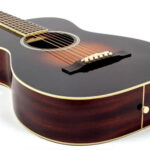Crafting the perfect guitar playing experience hinges on numerous factors, and often, the humble guitar strap is overlooked. A leather guitar strap, known for its durability and comfort, requires proper adjustment to ensure your instrument sits perfectly, allowing you to play for hours without strain. Understanding how to adjust your leather guitar strap is crucial for every guitarist, from beginner to seasoned professional. This guide will walk you through the essentials of guitar strap adjustment using leather straps, ensuring optimal playability and comfort.
Why Choose Leather for Your Guitar Strap?
Leather guitar straps are a popular choice for a reason. Beyond their aesthetic appeal, leather straps offer superior comfort and longevity. The material naturally contours to your body over time, providing a personalized fit that fabric or synthetic straps simply can’t match. Leather also distributes the weight of your guitar more evenly across your shoulder, reducing pressure points and preventing discomfort during long gigs or practice sessions. Furthermore, the robust nature of leather means your strap will withstand years of use, making it a worthwhile investment for any guitarist.
Understanding Different Adjustment Mechanisms in Leather Straps
Leather guitar straps come with various adjustment mechanisms, each offering a slightly different approach to finding your ideal guitar height. Common methods include:
- Buckle Adjustments: Similar to belts, these straps use a buckle system to lengthen or shorten the strap. They offer a wide range of adjustability and are very secure.
- Sliding Adjustments: These straps utilize two or three pieces of leather that slide against each other to change the overall length. They often provide finer adjustments and a sleek look.
- Hole and Peg Adjustments: Some leather straps use a series of holes and pegs, allowing you to select a pre-determined length. While less flexible than buckles or sliders, they are simple and reliable.
Identifying the type of adjustment mechanism on your leather strap is the first step to achieving the perfect fit.
Step-by-Step Guide to Adjusting Your Leather Guitar Strap
Adjusting your leather guitar strap is a straightforward process. Follow these steps to find your optimal playing height:
- Put on Your Guitar Strap: Attach your leather strap to your guitar, ensuring it is securely fastened to the strap buttons. Position the strap over your shoulder as you would when playing.
- Assess Initial Height: Stand or sit in your typical playing posture and observe where your guitar sits. Is it too high, too low, or just right? Consider if you prefer your guitar higher for seated playing or lower for standing.
- Locate the Adjustment Mechanism: Identify whether your strap uses a buckle, slider, or hole and peg system.
- Adjust the Length:
- Buckle Strap: Unbuckle the strap and move the buckle to the desired hole to lengthen or shorten it. Refasten the buckle securely.
- Slider Strap: Slide the adjustable leather piece up or down to change the strap’s length. Ensure the slider is firmly positioned after adjustment.
- Hole and Peg Strap: Remove the peg, reposition the strap to a different set of holes, and reinsert the peg securely.
- Re-assess and Fine-tune: Put your guitar back on and check the new height. Play a few chords or riffs to see how comfortable and playable it feels. Repeat steps 4 and 5 until you reach your desired guitar position.
- Consider Playing Style: Your preferred playing style might influence your ideal strap height. For example, lead guitarists might prefer a slightly higher guitar position for easier access to higher frets, while rhythm players might opt for a lower position for a more relaxed feel.
Tips for Optimal Leather Guitar Strap Adjustment and Comfort
- Adjust While Standing and Sitting: Ideally, adjust your strap while both standing and sitting to find a compromise that works well in both positions, or set different straps for each if you primarily play in one position.
- Break-in Your Leather Strap: New leather straps can be stiff. Allow time for your leather strap to break in and soften, as this will improve comfort and how it conforms to your body.
- Use Strap Locks: Once you’ve found your perfect strap adjustment, consider using strap locks to prevent accidental strap detachment, especially with leather straps which can sometimes loosen over time at the attachment points.
- Regularly Check Adjustment: Leather can stretch slightly over time. Periodically check your strap adjustment to ensure your guitar remains at your preferred height.
- Experiment with Different Heights: Don’t be afraid to experiment with different strap heights to discover what feels most comfortable and enhances your playing. Small adjustments can make a big difference.
Conclusion
Proper guitar strap adjustment, particularly with a comfortable and durable leather strap, is fundamental to enjoyable and efficient guitar playing. By understanding the different adjustment types and following a systematic approach, you can easily find the sweet spot that allows you to play comfortably for hours. Take the time to adjust your leather guitar strap correctly, and you’ll not only improve your playing experience but also reduce strain and fatigue, letting you focus on what truly matters – making music.

